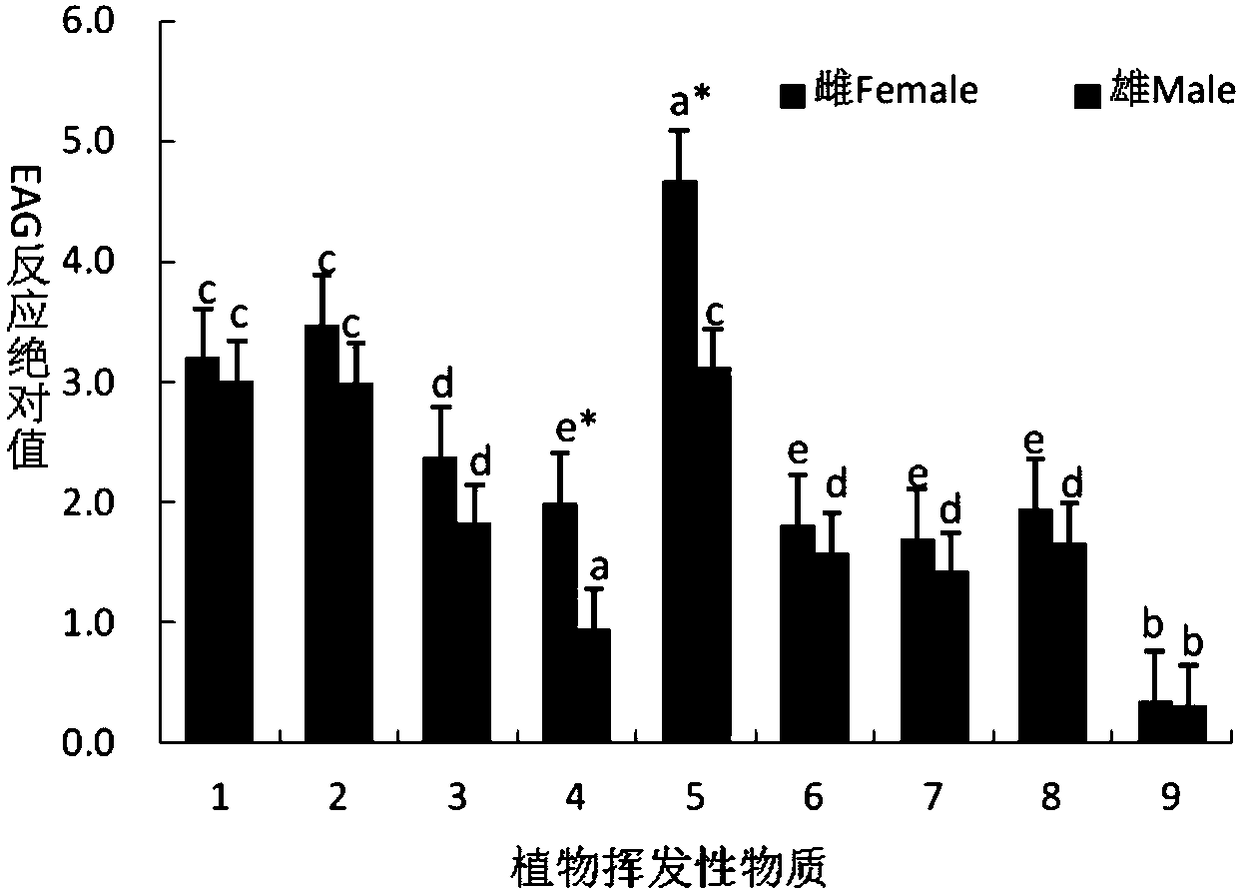Lygus pratensis linnaeus host plant volatile matter and application thereof
A technology of Lygus and host plants, which is applied in the fields of application, plant growth regulator, botanical equipment and methods, etc., can solve the problems of hidden harm, increased harm of Lygus, and easy to be ignored, and achieve the effect of preventing disasters
- Summary
- Abstract
- Description
- Claims
- Application Information
AI Technical Summary
Problems solved by technology
Method used
Image
Examples
Embodiment 1
[0022] The volatiles of the host plants of Lygus graminis were extracted by solid-phase microextraction (SPME).
[0023] Freshly isolated plants were taken before the experiment, and the wound part was wrapped with a cotton ball soaked in water to prevent the emission of volatiles produced by the wound, and brought back to the laboratory quickly. The host plant plants brought back to the laboratory were put into a 500ml wide-mouth bottle, and the mouth of the bottle was plugged tightly with a silica gel stopper. Place the extraction head in the GC inlet at 250°C for 1 hour activation, fix the SPME handle with an iron stand, slowly push out the extraction head, insert it into a jar, and extract volatiles for 40 minutes.
[0024] The extracts were separated and determined by GC-MS technology. figure 1 The GC-MS detection patterns of volatiles of 7 kinds of host plants of Lygus forages, respectively. Combining computer retrieval technology to identify the isolated compounds, a ...
Embodiment 2
[0036] Determination of Electroantennary Potential (EAG) Response of Lygus Lygus to Host Plant Volatile Odor Compound Standards
[0037]Measuring method of antennal potential: Take a 6-10-day-old female adult Lygus stinkbug with a finger-shaped tube, and then put it on ice to freeze to faint. Put it under a stereomicroscope with the ventral side up, press the abdomen with an insect needle, and cut it down quickly along the middle of the front leg segment of the Lygus ligus with a double-sided blade. After cutting, observe whether the tissue membrane at the part where the head is separated The tissue fluid flows out. If there is no tissue fluid flow out, it indicates that the membrane is intact and can be tested further; if the tissue membrane is ruptured, it cannot be used and needs to be prepared again. Afterwards, cut off a small part of the tips of the two antennae, and then use the prepared reference electrode (the capillary is soaked with 0.9% NaCl solution by weight) to ...
Embodiment 3
[0044] Determination of Approaching Behavioral Responses of Lygus Lygus Adults to Standard Odor Samples of Host Plant Volatile Compounds
[0045] The Y-type olfactory instrument was used to measure the tendency behavior of Lygus forage to 9 kinds of host plant volatiles. The Y-shaped olfactory instrument was made of colorless transparent glass with an inner diameter of 3 cm. 60°. The base is connected with the release tube of the adult ligus bug, the two arms are corked tightly, and the odor source is connected with a glass tube. Use a pipette gun to draw 10uL of liquid paraffin containing a single-component pure product and drop it on a folded filter paper strip (0.5cm×5cm). After standing for 30s, put the filter paper strip into a conical flask as a source of odor. Liquid paraffin was used as solvent and control. Use the QC-1B atmospheric sampler as the air flow power system, the odor source is connected to a vacuum pump, and before the air flow enters the odor source, it ...
PUM
 Login to View More
Login to View More Abstract
Description
Claims
Application Information
 Login to View More
Login to View More - R&D
- Intellectual Property
- Life Sciences
- Materials
- Tech Scout
- Unparalleled Data Quality
- Higher Quality Content
- 60% Fewer Hallucinations
Browse by: Latest US Patents, China's latest patents, Technical Efficacy Thesaurus, Application Domain, Technology Topic, Popular Technical Reports.
© 2025 PatSnap. All rights reserved.Legal|Privacy policy|Modern Slavery Act Transparency Statement|Sitemap|About US| Contact US: help@patsnap.com



